According to Pfizer, wellness is defined as the “act of practicing healthy habits on a daily basis” with the goal of improving physical and mental health. The Global Wellness Institute helps us narrow in on the definition by stating that wellness is characterized by an “active pursuit” of such healthy habits.
Office wellness is a well-researched and supported idea that many companies have invested in, but the shift to and sudden popularity of remote work has brought with it new challenges that require paradigm-shifting solutions. In many cases, standard wellness programs simply cannot be translated into the remote work environment.
This has necessitated the rise of so-called virtual wellness programs, targeted specifically at remote employees. In this blog post, we’ll provide you with 18 wellness ideas for remote employees. But before that, let’s look at what benefits you can expect to gain from them.
Table of Contents
18 Virtual wellness ideas to try
Through our virtual wellness tips targeted specifically at remote employees, we sought to address some of the main issues plaguing such employees, like lack of physical activity, loneliness, home office set-up and maintenance costs, unhealthy habits, and so on.
1. Define a wellness budget
We’ve all been to elementary school, so there’s no need to state the obvious like “smoking is bad, you shouldn’t do it,” or “exercise is good for you,” or “eat more healthy food,” — your employees already know this.
What they need is a nudge in the right direction, and that’s where you can help. One of the more financially involved wellness tips you can employ is setting up a wellness budget. In short, this is a cost-covering perk for things like a gym membership, yoga classes, swimming lessons, etc. Employees can purchase said membership, classes, and/or lessons, submit the receipts to the company, and get reimbursed.
The details of how you go about this are entirely up to you and your budgetary constraints, although the simplest solution is to decide on a per-employee monthly budget, decide which services the budget will recognize as valid, and let the employees take it from there. The flexibility of this system will benefit more employees than a strict gym membership perk since some employees simply prefer other types of physical activity.
Establishing a wellness budget will motivate employees to tap into the said budget, and since you get to decide what’s valid for reimbursement and not, you can effectively steer the employees towards healthy options. The leeway in choosing where to spend the budget also prevents you from falling into the trap of investing in wellness benefits that employees aren’t interested in, like educational tools or printed wellness information.
2. Define an ergonomic office budget
The most common cause of workplace injury in an office environment is MSD (musculoskeletal disorder). Back pain and a sedentary lifestyle seem to go hand in hand, but MSD also includes other conditions such as carpal tunnel.
In an office setting, ergonomic equipment is one of the most effective measures for combating sedentary MSDs. There are guides on office ergonomics that can help you understand how to select the optimal equipment (chair, desk, keyboard, wrist rest, monitor, etc.) and adjust it to your body so that you can greatly reduce the risk of MSDs.
The problem is this — ergonomic equipment is expensive; too expensive for most remote workers to cobble together on their own.
But your company can contribute to remote employees’ overall health and wellbeing by loaning such ergonomic equipment or reimbursing its cost.
This could either be done upon the employee joining the company or hitting an important milestone (such as a one-year anniversary at the company).
In any case, guaranteeing that your remote employees have the benefit of ergonomically set-up home offices will do wonders for their health and overall well-being.
3. Introduce a work buddy system
The lack of physical activity is hardly the only issue that plagues remote employees. Another commonly faced problem in this working environment is loneliness, which this study shows is faced by 20% of remote workers. The severity of this issue is magnified by the fact that most of the studies were conducted during the pandemic when the majority of the workforce was forced into a WHF environment regardless of their preferences; the majority of these workers will migrate back to their offices at the first given chance, significantly reducing this apparent drawback of remote work.
Nevertheless, this is something you should bear in mind, lest you suffer the consequences. The aforementioned study does link loneliness to a drop in productivity. Throughout this blog post, you’ll see many wellness tips aimed at addressing this issue, but the work buddy system is one of the simplest solutions.
What it entails is pairing two remote employees from your company and getting them to schedule a couple of one-on-one video calls throughout the week. During these buddy meetings, the employees can talk about anything; it doesn’t have to be work-related, although it does count towards their working hours. Consider it a shared coffee break. The idea is to mimic the office environment, where employees are bound to engage in conversation at one point or another. This has the added benefit of building rapport among remote employees, which doesn’t naturally occur without some outside help. After a set time (week, two weeks, month) you can change the pairings.
4. Try the “good habit” challenge
Eat more greens, drink more water, walk ten thousand steps a day…
It sure sounds easy. But adopting good habits takes time, perseverance, and, in most cases, a healthy dose of outside encouragement.
For example, let’s focus on drinking more water. According to Mayo Clinic, an adequate daily intake of fluids amounts to 15.5 cups (3.7 liters) for adult men and 11.5 cups (2.7 liters) for adult women. Around 20% of daily fluid intake is covered by the food we eat via digestion, but this still leaves us with lots of water to drink.
To encourage your remote employees to drink more water, you can turn it into a challenge by creating a shared Excel file with remote workers’ names as the rows and dates as the columns. The employees can then use pluses and minuses to mark whether or not they have maintained the habit throughout any given day.
| October 21st | October 22nd | October 23rd | October 24th | October 25th | |
| Avdol Mohammed | + | + | + | + | + |
| Jean Pierre Polnareff | + | + | + | – | – |
| Joseph Joestar | – | + | + | – | + |
You can motivate them by including rewards for successful habit-forming. Do keep in mind, though, that rewarding only employees with a perfect score will only serve to discourage others as soon as they miss a single day. We’re well aware that the myth of creating a habit in 21 days has been debunked, but people are comfortable with this number, so choosing it as the number of days in a month required to win the reward will give breathing room for employees who wish to better themselves but need more time to get adjusted. By the way, when we say rewards for these challenges, we mean something small like a $10 gift card — the good habit should be its own reward.
Once the month is over, you can do the same thing all over again or switch to a new good habit.
5. Exterminate bad habits
While forming good habits is important, it’s no excuse for letting bad habits fester. What’s great is that you can incorporate good habit adoption into bad habit elimination.
For example, if your remote workers are struggling with quitting smoking, you can help them along by setting up challenges similar to the ones previously mentioned. There’s only one rule — every time they get the craving for a smoke, they should do something healthy instead. For example, if you feel like lighting a cigarette, do 10 push-ups or jumping jacks instead. This needn’t be physical activity, either. You can drink a glass of water or eat a pickle.
As great as this system of replacing bad habits with healthy activities is on paper, it may be too ambitious for some. In these cases, you can use other, not necessarily healthy but not unhealthy craving-busting methods, like chewing bubble gum instead of smoking.
In any case, make sure remote employees can track their progress on a shared Excel sheet or similar resource, like a #quit-bad-habits channel on Pumble. This will let them know they aren’t alone in fighting this fight and can discuss their experiences with other remote employees whose names are on the list. Also, don’t forget to reward their efforts. Just remember that breaking bad habits, especially ones which are characterized by actual chemical addiction like smoking, can be way harder than adopting good habits, so forget about the 21-day requirement — instead, celebrate every successful day as a victory.
6. Clean virtual workspaces
It’s a mistake to assume that the digital nature of most remote work renders employees immune to the analog goings-on in their home office. It’s not merely the speed of their Internet (or lack thereof) and peripheral or hardware malfunction that can negatively affect our mood and job performance. Several researchers have found that cluttered and untidy spaces increase stress and anxiety levels.
To this end, keeping your desk clean can have a hugely positive impact on your overall wellness, work productivity included.
You can encourage remote employees to do this in several ways, not least of which is including house cleaning as a service covered by your wellness budget (should you have one). However, a much more inexpensive solution may be to dedicate a channel on your workspace in Pumble or a similar work chat app to posting pictures of clean home office desks — call it the #clean-desk-challenge or #clocking-out.
You can take this a step further to improve your remote employee wellness by using this tip to help them exercise their right to disconnect. Since most remote work is characterized by flexible hours, where not all employees are expected to start and finish their work at the same time, this can lead to uncertainty and misunderstandings about whom you can and should message at what time. Explain to remote employees at your company that the way to signal they have finished work for the day is by posting a picture of their tidy workspace onto the #clocking-out channel. If you have lots of remote employees, making a separate channel for each team is recommended.
This way, you’ll be killing two birds with one stone, all in service of improving remote employee wellness.
7. Have a go at online group physical activities
This one is an umbrella tip for various types of physical activities aimed at getting remote workers moving — we’re talking online yoga, online stretching, online resistance training, and even online meditation, if you don’t mind the semantics of it.
Physiologically, the sedentary nature of most remote work can quickly lead to slouching, which contracts lungs and limits the flow of oxygen throughout the body and brain. Therefore, exercising will not only keep your body healthier but your mind sharper, too. So why don’t we all exercise?
It’s often not the lack of a gym membership card that stops people from exercising, but just the lonely nature of this act. A training buddy can be an effective means of providing the motivation to keep going. And if you can get the whole team involved and participating, ideally over a video call, that’s even better. Our health contributes to our overall happiness, and happiness is linked with all sorts of benefits.
But you can’t just organize a video call and tell your employees to start doing jumping jacks. For this, you have two options:
- Hire a professional: You can pay a professional to lead these online physical activity sessions. This minimizes the risk of injury and inspires faith in the company and their concern for employee wellbeing.
- Get an experienced employee to lead: This can also work, but it works better for some activities than others. For example, if an employee practiced gymnastics, getting them to run your online stretching sessions can be a great idea (just be sure to compensate them). But, if you’re considering resistance training, turning to the resident gym-goer may not be such a good idea. In such cases, it’s best to turn to a professional physical therapist to ensure your employees aren’t inadvertently doing damage to their bodies.
8. Practice healthy eating
There is this idea that, because they don’t spend time commuting to and from work, remote employees have more time to cook. In fact, there are studies that support this. But healthy dietary habits don’t spontaneously emerge out of thin air, especially not in individuals who aren’t used to them.
You can promote healthy eating to your employees by hiring chefs to hold virtual cooking courses and create easy-to-cook but nutritious (and delicious) recipes. It’s not that people don’t know eating fast and processed food is bad for your health — it’s just that they may not be used to having alternatives. To keep things simple and familiar, we suggest starting by focusing on healthy alternatives to foods they already eat. For example, what healthy snacks you can use as a replacement for that bag of chips you’re so intimately familiar with?
Speaking of snacks, sending your employees a gift box of healthy snacks can be a nice gesture that contributes to the overall goal of improving wellness. Most companies stack their offices with (hopefully healthy) snacks that employees are free to consume, so extending a similar gesture to remote employees shouldn’t be that hard.
Alternatively, you can include meal subscriptions either as a perk or an applicable cost towards your wellness budget (if you have one).
Whichever of these routes you opt to take, nurturing the wellness of your remote employees through healthy food is a surefire hit.
9. Try some pet therapy
Pet therapy — or animal-assisted therapy (AAT), if you want to get technical about it — is a proven way of raising morale and maintaining positivity among employees. There’s a reason some offices adopt cats or other pets — pets reduce stress and boost productivity.
Not only will adopting a pet motivate remote employees to get some exercise while walking them, but it will also keep the employees feeling good and happy by increasing the levels of oxytocin and serotonin. Unfortunately, you can’t just make it a job requirement for employees to get a pet. Some live in apartments that don’t allow them and some are allergic to most kinds of pets. But this doesn’t stop you from hosting online pet therapy. There are two ways you can go about this:
- Video call: Create an informal conference call where pet owners among your remote employees can show off their furry friends. Evidence suggests that the mere act of watching animal pictures and videos can reduce stress and anxiety levels. Make sure everyone understands pet owners aren’t the only allowed participants. Thirty minutes of animal watching can reduce heart rate and blood pressure, and chances are non-owners are in bigger need of this.
- Pet channel: If your remote team is using a business messaging app like Pumble you can set up a #pets channel where employees can share pictures and videos of animals for everyone’s enjoyment. These needn’t be their own pets — but original content never hurts.
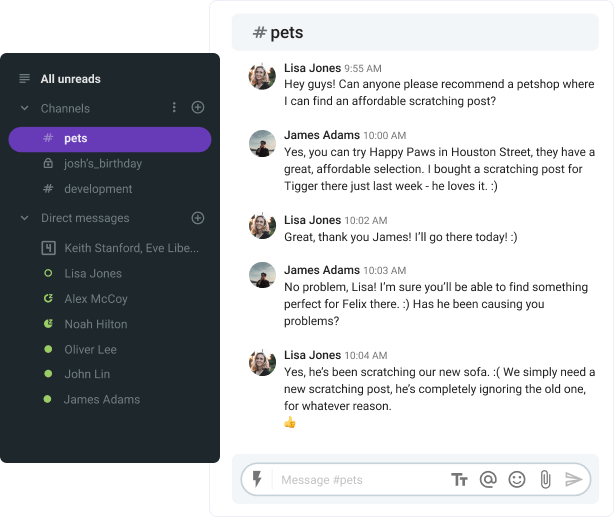
10. Make good use of your #random channel
Even if your remote workers don’t mind the isolation and don’t suffer from loneliness, communicating with co-workers can still be beneficial for their overall wellbeing. For remote workers, especially ones that have started their career in a company remotely and therefore haven’t had the chance to meet their co-workers in person, striking up a conversation can be difficult.
Many of the other tips in this blog post can help you get around this issue, such as the work buddy system and pet therapy, as well as some upcoming tips.
What these tips have in common is that they all have an agenda. “These two employees are paired up and are expected to communicate,” or “Pet-owners will show off their pets to everyone’s enjoyment.” But most of them rely on conference calls, which can quickly lead to video call fatigue.
Besides, anyone who’s ever worked at an office can tell you that the conversations held there don’t all have an agenda. Sometimes people just want to boast, tell a joke, get some human contact, or share memes.
On Pumble, every workspace gets a #random channel by default, which helps facilitate this type of communication. This provides remote employees with an outlet for sharing their random thoughts or funny memes. On Pumble, employees can mute these channels if notifications turn out to be a distraction, and only check in when they wish to engage with such content.
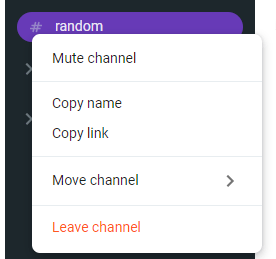
And, in case you feel this type of workplace chatter is undesirable, it may help to note that viewing memes has been linked with positive emotions, especially during stressful times. Providing a pillar of support for your employees will do more for their overall wellness than it will detract from their productivity.
11. Enable employees to create group channels
Relating to the previous example, you should use a team chat app that allows employees to form channels around topics that are relevant to their lives and interests.
This could be something as simple as a #movies or a #music-channel, letting employees identify others who share similar interests and bond over those interests.
There could even be channels related to their life situations like #parents, or ones related to breaking bad habits, like #no-smoking, where employees going through the same ordeal can offer support and motivation.
In fact, most of the wellness tips mentioned in this article would be better off with an accompanying channel — #workout can be used for sharing quick and home-friendly exercise videos, #diet can be used for sharing simple yet nutritious recipes, and so on.
💡 For more ideas, check out our list of must-have channels for team chat apps. While you can’t go wrong by setting up several generic channels like the ones mentioned above, things get even better when employees feel comfortable making their own channels for others to join. Do not underestimate the benefits of grapevine communication in remote teams.
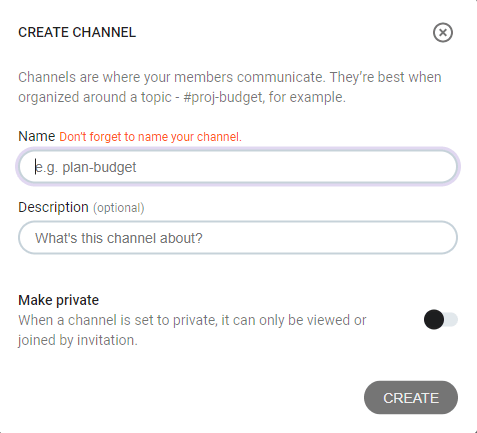
12. Organize game nights
Generations of digital natives raised on video games (or games in general) are flooding the workforce and bringing with them new values and behaviors. The friendships forged through gaming can be as superficial, but also as genuine as any others. During the early days of the pandemic marked by complete lockdowns, many turned to video games to fend off loneliness and isolation, as evidenced by PlayStation’s huge player count rise in the spring of 2020.
While the demand for the PS Plus subscription has gone down in 2021, gaming remains a hobby that 80% of Millennials and Gen-Z partake in.
To this end, hosting a virtual game night (especially if the majority of your remote employees are Gen-Z or Millenials) will not only provide a genuine bonding experience, it will also help combat the loneliness issue in employees who otherwise wouldn’t participate in online gaming. Everyone can enjoy a game of Mario Kart, although there are plenty of free or almost free games out there that would be perfect for a group of people, like Counter-Strike or Among Us. Workplace friends have also been shown as an important factor in employee retention, and few things forge friendships as quickly for digital natives as video gaming.
Of course, you aren’t limited to video games. There are plenty of other games you can play over a conference call or group chat. You can find them in our list of over 40 team-building games.
13. Introduce shared digital office hours
The title of this may sound vague, so here’s the gist of it — shared digital office hours refers to a block of time during which all remote employees in a team will go about their business while connected to a voice or video conference call. Normally, we’d insist on video calls, but in this case, just voice is fine, as employees will be doing other work regardless. They can keep their microphones muted unless they specifically want to engage in conversation with other team members. As for the conversations, these should be work-related. The idea here is to once again emulate an office environment in an effort to build team trust and combat feelings of isolation.
14. Try plant decorations
It has been shown that a bit of greenery can positively impact productivity. It should be noted that these experiments have been conducted in pre-pandemic office settings — but, with the large-scale WFH movement still in relative infancy and research for niche applications such as these lacking, we have to take what we know about the office environment and hope for the best.
Since purchasing a houseplant is one of the more inexpensive tips on this list, employees can try it out and confirm how well the positive effects of greenery translate to the home office environment. But the company can certainly help things along. Houseplants top many lists of gift ideas for remote employees. If nothing else, receiving a gift like this will put a smile on remote employees’ faces, which can be its own reward.
15. Subsidize home office expenses
Financial well-being certainly constitutes a part of your employees’ overall wellness. But more often than not, WFH employees are forced to take care of their own day-to-day office expenses which would otherwise be managed by the company in an office setting. Think about it: when an employee comes to the office, they’ve got everything handed to them, from a computer with all peripherals included to the chair, desk, and finally good Internet.
Many remote-first or hybrid companies offer their employees laptops, printers, or similar necessary gadgets, and some even offer ergonomic office furniture — but what about the Internet connection?
For something as integral to the overall workflow of any remote employee, the Internet connection is rarely subsidized, which may force some employees to rely on slower than optimal Internet. If slow Internet can lead to increased levels of stress while doing something mundane, such as video streaming, just imagine what detrimental effects it can have on the well-being of your employees who are struggling to maintain productivity or attend every video call.
The authorities in the Netherlands have calculated the average workplace expense per employee and granted all government employees a $429 COVID-19 bonus, to be spent towards such office expenses.
In most cases, though, it would be simpler to subsidize the costs of Internet upgrades to ensure a baseline playing field from which all your remote employees will operate.
16. Promote breaks/PTO
With how novel remote work still is, it’s no wonder that a code of conduct surrounding such questions as breaks, PTO, and even sick days, hasn’t been established in the collective consciousness. You can find guidelines and suggestions online, but nothing beats hearing the info straight from your boss or manager.
There is a stigma associated with remote work, characterized by lazing around, lengthy breaks, and pajamas, of all things. Remote employees are well aware of this stigma, leading many to unhealthy practices such as taking no breaks and not using paid time off to combat it. But these efforts can only serve to backfire in the long run, by leaving employees feeling burnt out and possibly bitter.
One thing you can do to promote the virtual wellness of your employees is to communicate the need for remote employees to take breaks throughout the day and take their paid time off. They have earned it, just as much as any other employee. It’s best if you communicate this as a requirement. Breaks are integral to maintaining productivity throughout the day, and they also decrease stress while they’re at it.
According to the 10th principle of effective communication in remote teams, no message should be left incomplete. Unless you openly communicate your thoughts and expectations regarding breaks and PTO (and sick days!), you can’t expect your remote employees to act accordingly.
17. Remind employees to take sick days
It’s been shown that, for various reasons, remote employees are reluctant to take sick days, and instead soldier through their daily duties with fevers, shivers, and so on. If you think about it, many in-office employees come to work when they feel they aren’t “sick enough” for a sick day, — only, in this case, they have their fellow co-workers to shoo them off home for their own good. Remote employees are on their own, so simply reminding them and encouraging them to take sick days when they are sick is important.
It may help to lead by example, by ensuring that managers and team leaders also take their sick days seriously. Rest and recovery are essential when you’re sick, and while sitting in front of the computer may not seem like much, it does hamper this process.
Communicating to the rest of the team that you are on sick leave is also essential. On Pumble, you can easily do this by updating your status to display a sick emoji (🤒) for a set period of days. This will instantly let others who thought of contacting you that they shouldn’t tempt you with work.
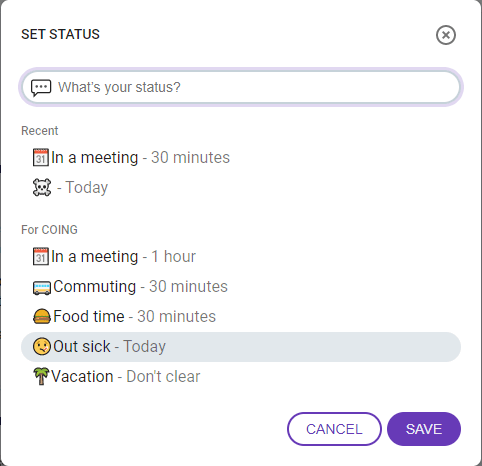
18. Encourage routines
Remote work hours can sometimes be so flexible they lead to time distorting practices of waking up late, working till late, and not having enough time to do anything soul-nourishing as the line between work and home becomes indistinguishably blurred. When remote employees are unable to effectively disconnect from work, burnout follows.
By promoting certain work routines, like standardized work hours, you can help set up your remote employees for a successful and stress-free day. Establishing work-life boundaries is essential for the well-being of remote workers and routines help tremendously here. Keep in mind that requiring strict adherence to these work hours may be off-putting to some. Let them know that they can report any deviations to their team leader. The idea isn’t to alienate your remote employees but to help them.
Sticking to the work hours example, let’s first ask ourselves: Why has 9 to 5 become the standard? The popular opinion is that it’s simply an outdated relic, but there’s more to it. Even in today’s office-work climate, it’s necessitated by the context of long commutes. Demanding that employees start working at 7 or even 8 is logistically difficult when their commute takes an hour and a half.
But most remote employees don’t commute. Encouraging them to start work at 7 or 8 would mean they get off at 3 or 4 respectively. Anything earlier than this can make it difficult to coordinate team efforts since not everyone will take to this proposed schedule. Nevertheless, having employees finish work by 3 in the afternoon with the knowledge that they are free to disconnect and turn all of their attention to their family, friends, and hobbies will do wonders for their overall well-being.
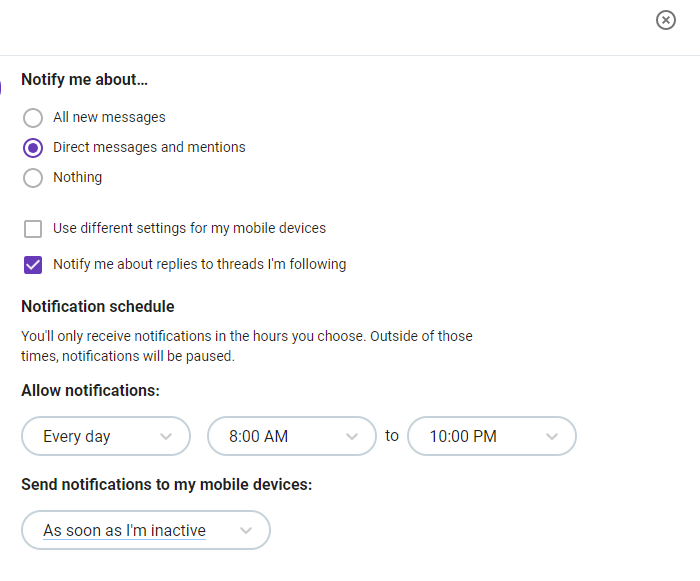
Benefits of virtual wellness programs
The result of an effective wellness program — virtual or otherwise — includes, but is not limited to, the following:
- Healthier behavior, which includes healthier dietary habits, and increased physical activity
- Reduced stress and anxiety, which helps lower chances for burnout
- Increased employee happiness, which comes from helping said employees maintain their good mental health
- Rise in productivity, which comes from enabling employees with all the tools needed to do their job.
- Higher employee retention, which will come naturally as wellness programs build loyalty
- Reduced health care costs, which come as a result of healthier behavior
Furthermore, we have to stress that well thought out and well-executed wellness programs pay for themselves. One example of this is Johnson & Johnson, a company that managed to drop the rate of smoking and increase the rate of physical activity in their employees to such an extent that they estimated to have saved $250 million on health care costs.
Conclusion: Remote employees require remote-friendly wellness plans
The benefits of investing in employee wellness are many and well-documented. Employees get the care and love they deserve, and companies get increased productivity, loyalty, and retention. With these 18 virtual wellness tips, you can ensure that your remote employees reap the same benefits by combating issues most commonly faced in the remote work environment, like loneliness, lack of physical activity, home office costs, and so on.





